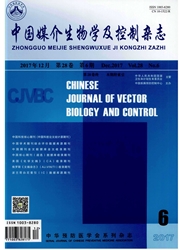

 中文摘要:
中文摘要:
目的分析长江三峡工程重庆段蓄水前后库区鼠疫相关鼠形动物种群数量变化情况,为评价三峡库区鼠疫流行潜在危险性提供依据。方法 1997-2012年,在三峡库区蓄水前后采用鼠夹法和鼠笼法调查库区鼠形动物,分析鼠疫相关鼠类密度变化趋势。结果蓄水前库区鼠密度室内为4.14%,室外为4.29%;蓄水后库区鼠密度室内为1.67%,室外为1.44%;蓄水前高于蓄水后。但是,黄胸鼠室内密度在蓄水后近两年有明显增高,2011、2012年分别达到0.84%和0.77%,远高于2004-2010年鼠密度。结论长江三峡工程二期蓄水后库区鼠密度明显降低,作为南方家鼠鼠疫主要宿主黄胸鼠的密度有增高趋势,应引起注意,需要进一步监测。
 英文摘要:
英文摘要:
Objective To investigate the change of the characteristics of rodents before and after the water storage in the Three Gorges Reservoir. Methods Mouse traps and cages were used to detect the density of rodents in different periods of the Water Storage. Results The indoor density of rodents before water storage was 4.14%. While it was 1.67% after water storage; the outdoor density of rodents before water storage was 4.29%, and it was 1.44% after water storage. The former was higher. The indoors densities of Rattus tanezumi in recent two years were much higher than before, it was 0.84% in 2011 and was 0.77% in 2012. Conclusion The densities of rodents significantly decreased after the second water storage in the Three Gorges Reservoir. But the indoors densities of R. tanezumi in recent two years were much higher than before. Continuous monitoring of rodent populations is warranted.
 同期刊论文项目
同期刊论文项目
 同项目期刊论文
同项目期刊论文
 期刊信息
期刊信息
